Submitted by WA Contents
Sumayya Vally spotlights seven artworks at the 2023 Islamic Arts Biennale
Saudi Arabia Architecture News - Apr 12, 2023 - 13:32 4071 views

South African architect and Islamic Arts Biennale artistic director Sumayya Vally has picked seven artworks for World Architecture Community that she believed those artworks have embodied the themes of the 2023 Islamic Arts Biennale.
Themed as Awwal Bait (First House), Sumayya Vally, who is the founder of Counterspace, believes that the first Islamic Arts Biennale in Jeddah, Saudi Arabia "is a historic moment for the canon of Islamic Art."
2023 Islamic Arts Biennale is taking place from January 23 to May 23 (the biennale has recently been extended from 23 April to 23 May) in the Western Hajj Terminal designed by Skidmore, Owings & Merrill in 1981 in Jeddah, Saudi Arabia.
Set within "a desert-like landscape", where the scenography was worked by OMA, Vally served as Artistic Director of Saudi Arabia's inaugural Islamic Arts Biennale.
Speaking to World Architecture Community in an exclusive interview, the architect believes that the biennale brings "a different definition of Islamic Art".
Underlining how the philosophies of Islam and the potential forms of being can offer creative worlds in relation to art, the architect picked seven artworks that embody the themes of the biennale for World Architecture Community.
Read on to see the seven artworks she considers these works have embodied the themes of the 2023 Islamic Arts Biennale:
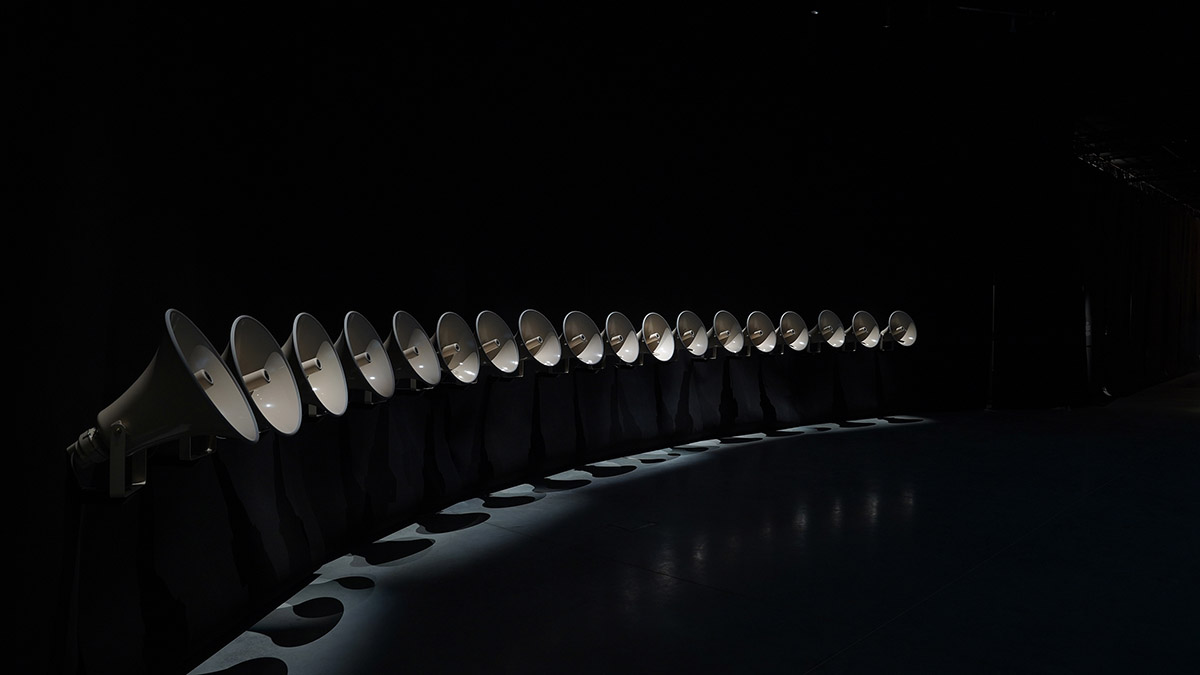
Cosmic Breath by Joe Namy. Image courtesy of Diriyah Biennale Foundation
Cosmic Breath by Joe Namy (Qiblah – Gallery 1 Adhan -The Call)
"In a celebration of the humble everyday prayer, Joe Namy’s Cosmic Breath choreographs the call to prayer from eighteen different, often unexpected locations, across different time zones. These include for example, a petrol station in Jakarta, a parking lot in Detroit, the side of the street, a chip shop in Cape Town, to name a few."
"He's recorded these and choreographed them so that the call starts at the same time, reflecting on the idea of cosmic breath, that every second of the day the call to prayer is being called somewhere on Earth, because it moves with the movement of the sun. And there are five a day, so when we stand up in prayer, we're joining this undulating rhythm and this undulating call, we're joining with people who do the same. So many of our practices are not able to be held in traditional archives because they're not written forms. They're oral, passed down from generation to generation, from body to body."
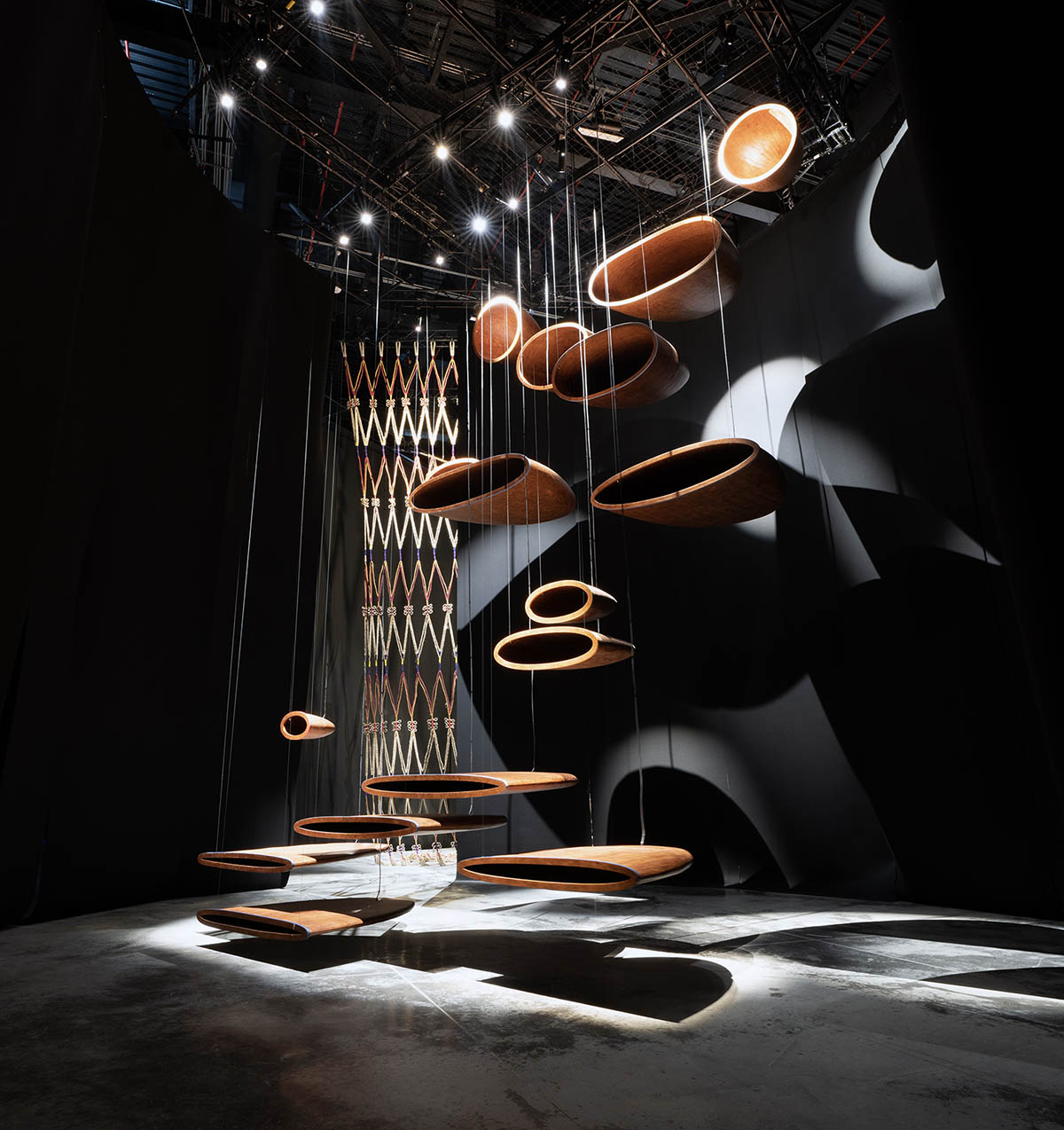
Wave Catcher by Basmah Felemban. Image courtesy of Diriyah Biennale Foundation
Wave Catcher by Basmah Felemban (Qiblah – Gallery 1 Adhan -The Call)
"Basmah Felemban places forms in space to give material expression to the call to prayer. She has adapted a method of visualization in which spheres represent sounds, and their size, shape, and placement indicate pitch and duration."
"They resemble traditional drums, or the fishing traps used on the east coast of Saudi Arabia, and their materiality refers to the teak wood used in fishing and trading vessels of the Hijaz, echoing the maritime associations of buhur. A soundscape of ocean waves reinterprets elements of the adhan, and reminds us of the invisible sound waves that carry it to our ears."
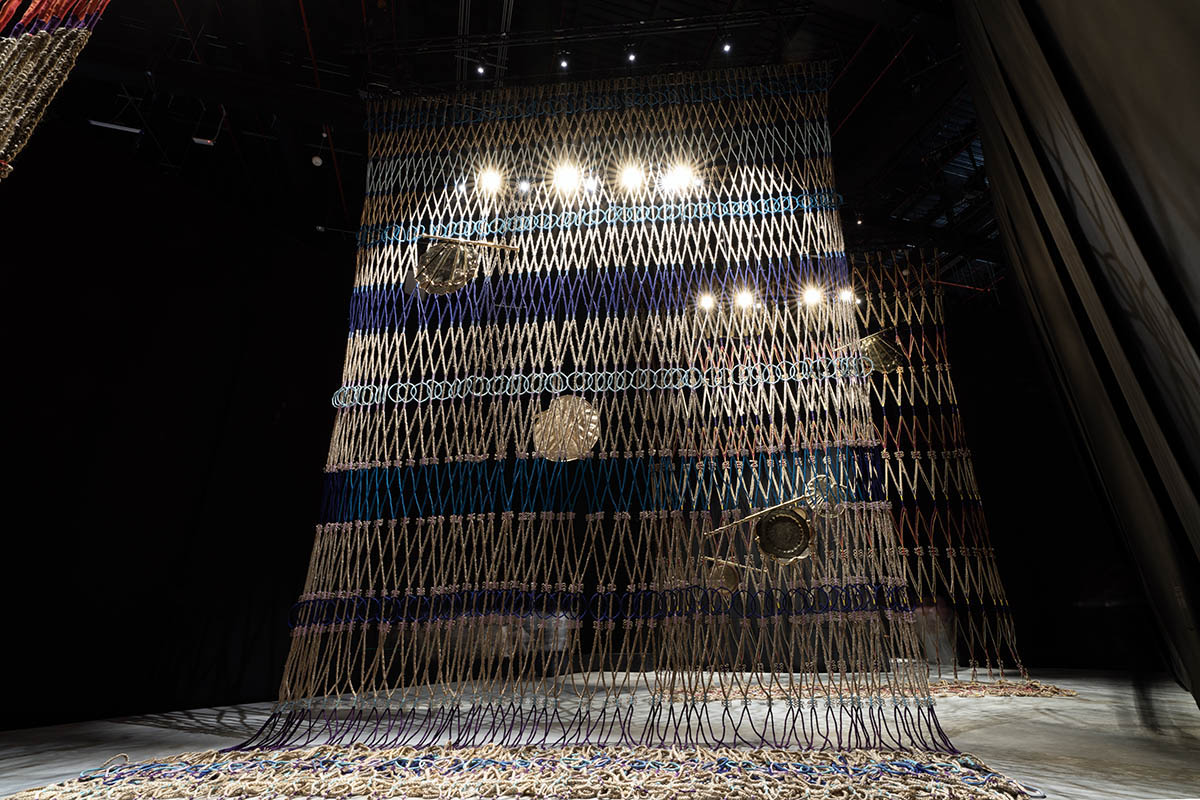
The River Remembers by Kamruzzaman Shadhin. Image courtesy of Diriyah Biennale Foundation
The River Remembers by Kamruzzaman Shadhin (Qiblah – Gallery 1 Adhan -The Call)
"Kamruzzaman Shadhin (b. 1974, Thakurgaon, Bangladesh) grew up listening to stories of displacement. His mother told him of the homes of her childhood, especially her grandparents’ house beside the Teesta river, lost when the partition of Bengal in 1947 forced her family to resettle in Bangladesh. Another inhabitant of his village, Johura Begum, also recalled her journey across the new border, from her birthplace in Assam, down the Brahmaputra river to her eventual home. Such stories shaped the artist’s imagination and with them he inherited a strange longing for places where he had never lived."
"The River Remembers responds to these stories. Its multiple monumental veils have been woven using the traditional shika knotting technique—Johura Begum’s own craft. Different colored threads correspond to the color of the water at various points on the Teesta and Brahmaputra rivers, while brass disks hang in front of the regions remembered by the two women, each disk engraved with their stories. Using the powerful imagery of rivers to suggest the unseen forces that can direct the course of our lives, this very personal work speaks eloquently of migration, ecology, and, most of all, of dislocation and homecoming."
Holy Limits by Nasser Al Salem. Image courtesy of Diriyah Biennale Foundation
Holy Limits by Nasser Al Salem (Qiblah – Gallery 4 Bait – House of God)
"The Ka‘bah’s holiness is defined by the acts of devotion to Allah that have been centred on it across time. Nasser Al Salem’s project for the Biennale reflects on this evolving ritual heritage. An installation that is also a contribution to the archive of knowledge about the building, the work takes for its source material verbal accounts across a long time period, and pays attention to the architectural details described. Weaving his calligraphic practice with his architectural training, he uses the words themselves to demarcate the boundary of the Ka‘bah and narrate minor shifts in its form. Through them, we understand that parts of the Ka‘bah have remained unchanged while others underwent a series of alterations that hold a significance only made visible in their reformulation."
"Al Salem has converted textual histories of the Ka‘bah into drawn forms, descriptions into calligraphic letters, where building and text are related through their proportions. His installation, outlining the Ka‘bah’s evolving footprint at full size, enables the visitor to experience and appreciate the scale of human and sacred space."
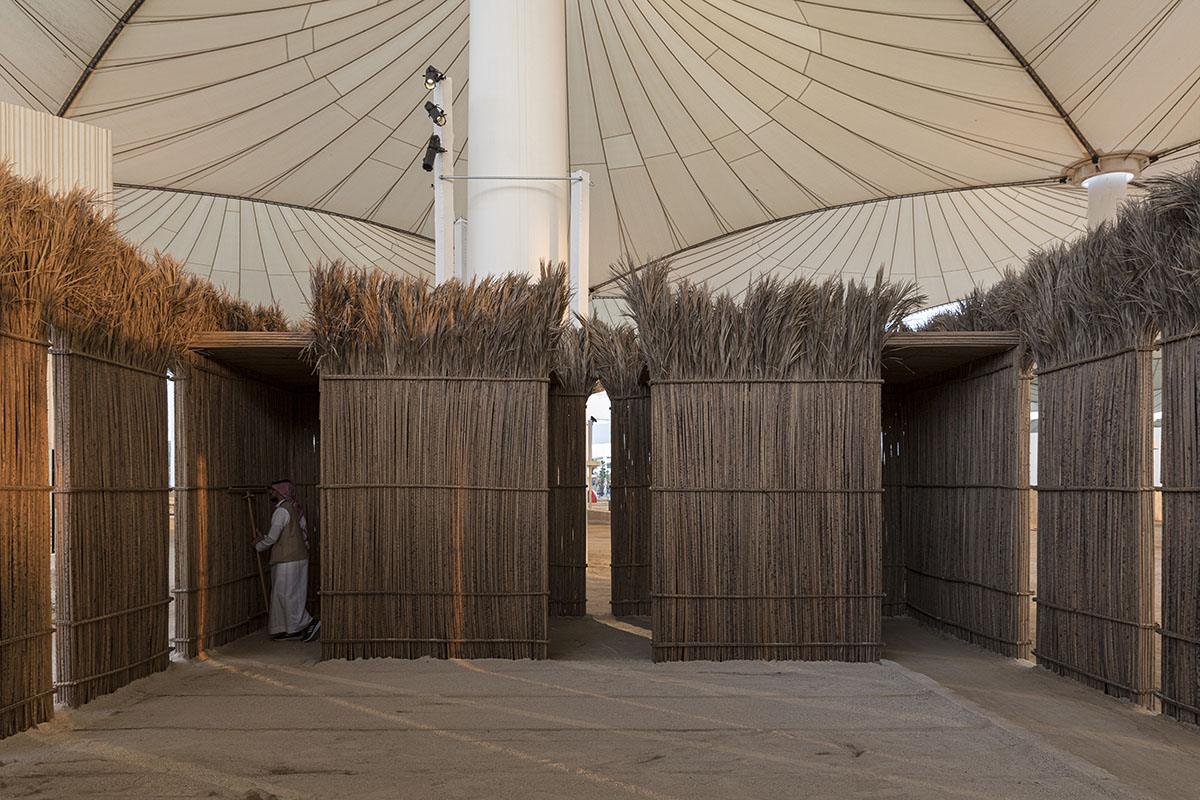
Anywhere can be a place of worship by Syn Architects. Image © Laurian Ghinitoiu
Anywhere can be a place of worship by Syn Architects (Hijrah –Migration)
"For their site-specific installation, Syn Architects have designed an enclosure that recalls the humility of this first musalla (“a place to pray”), reminiscent of the courtyard of the Prophet Muhammad (PBUH). The walls are formed from local palm reeds, woven together by Saudi artisans, recalling how temporary prayer spaces were once created along travel and pilgrimage routes. Gaps in the walls allow glimpses out to the immediate landscape where indigenous plants bloom, evoking the historic gardens of Madinah."
"Light from above falls on a slit that stands for the mihrab, emphasizing the role of the sun as a compass, determining the direction as well as the times of prayer. Simple maintenance—raking the ground and compacting the earth that supports the walls—is performed each day. Without these acts of care the structure would disappear entirely over time. Like ritual prayers, they construct and sustain its identity as a musalla and as a civic space. Like many of the works under the hijrah theme; the work itself is an invitation for gatherings. Through the life of the biennale, the musallah will host gatherings, prayer and discussions."
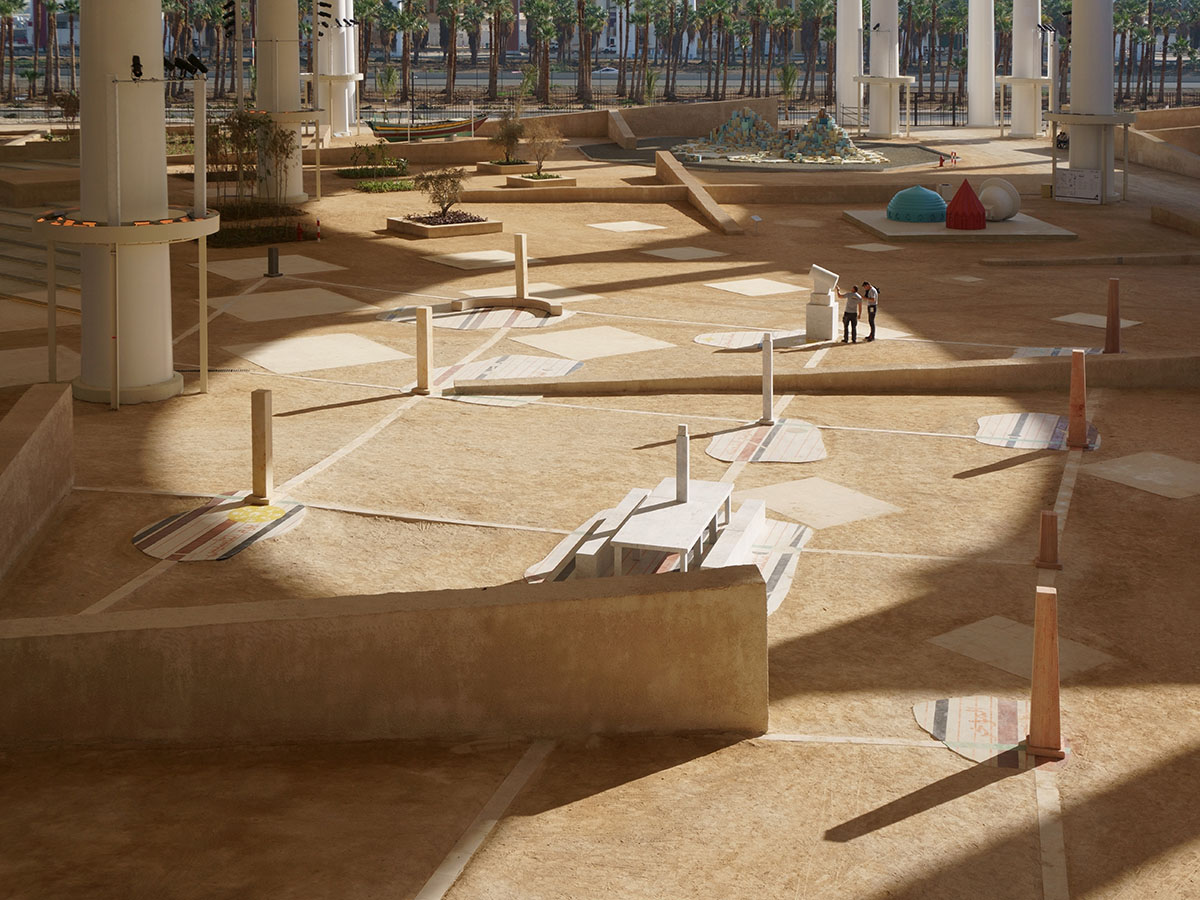
Sun Path by Civil Architecture. Image © Ali Ismail Karimi
Sun Path, Rajab to Shawwal 1444 by Civil Architecture (Hijrah –Migration)
"Traditionally, mosque courtyards featured a sundial that indicated the time of the five daily prayers, and mosques served as spaces where the general public could align their sense of time with the movement of the heavenly bodies."
"Inspired by the architecture of the Hajj Terminal, Civil Architecture have reimagined the sundial. The round opening (oculus) in each unit of the terminal’s canopy, which limits the amount of direct sunlight passing into the space below, acts as an inverted sundial. The installation in turn tracks the movement of a beam of sunlight rather than a cast shadow. This sunbeam passes over lines on the ground corresponding to the hours, months, and seasons, as well as sculptural objects that indicate significant moments in Islamic history and the hijri calendar, and events in the Biennale’s public program.
"Our sense of the sun’s movement and the color of the sky provide a general indication of the hour, in contrast to the abstract notion of time created by digital clocks, while the installation connects the space of the Biennale to events in the world beyond. The various dials will host gatherings, Artist activations and performances across the life of the biennale."
City as a Mosque by Studio Bound. Image © Ali Karimi
City as a Mosque by Studio Bound (Hijrah –Migration)
"Studio Bound operates in complex urban contexts across the Gulf, and aim to establish a dialogue between contemporary architecture and the region’s built heritage. In City as a Mosque, a product of many years of careful investigation, they have created a large-scale installation that honors the small mosques and other places of prayer—formal and informal—that have shaped the sacred landscape of Makkah."
"Beneath the Hajj Terminal’s 1980s canopy there is a circular excavation, its uneven surface suggesting different layers of uncovered history. The area of each mosque is marked out by stone tiles in which the floorplan is carved out and overlaid with geometric patterns taken from prayer carpets. The buildings defined so clearly here relate to now invisible forms within the holy city. In this space without walls, these mosques exist only as traces yet retain their spiritual gravity, holding the possibility of future excavation and reanimation."
Top image in the article: Anywhere can be a place of worship by Syn Architects. Image © Laurian Ghinitoiu.
> via Counterspace
